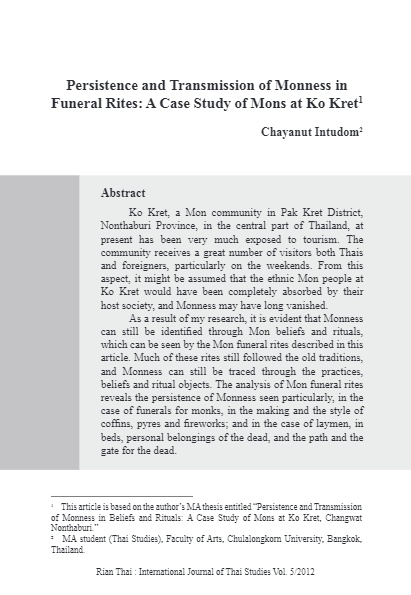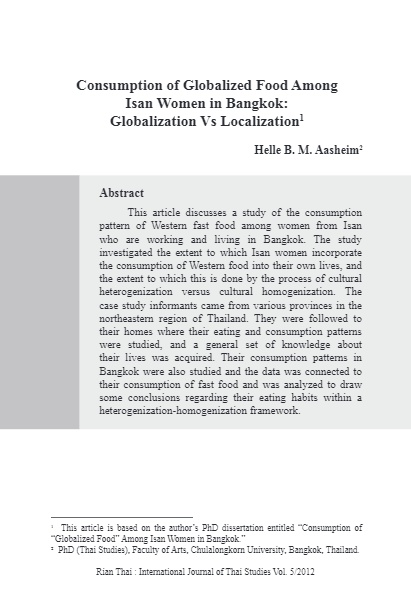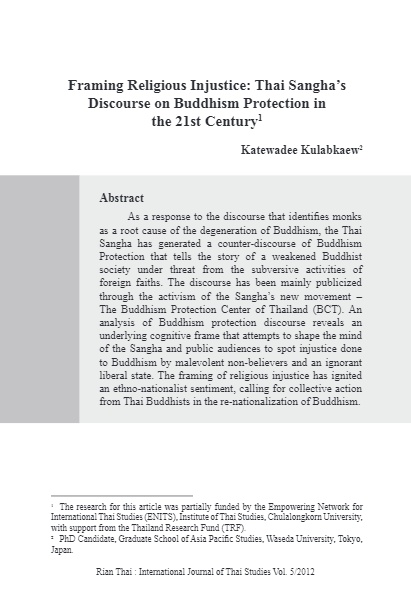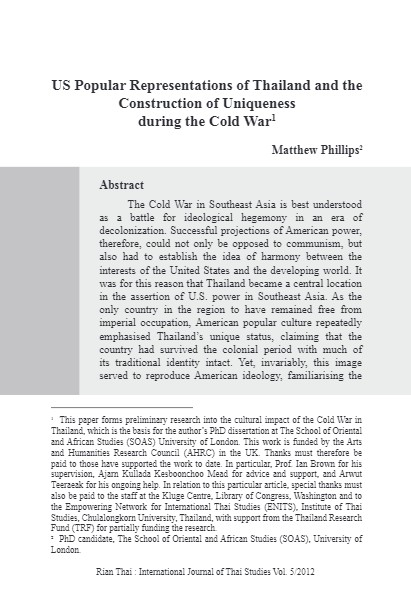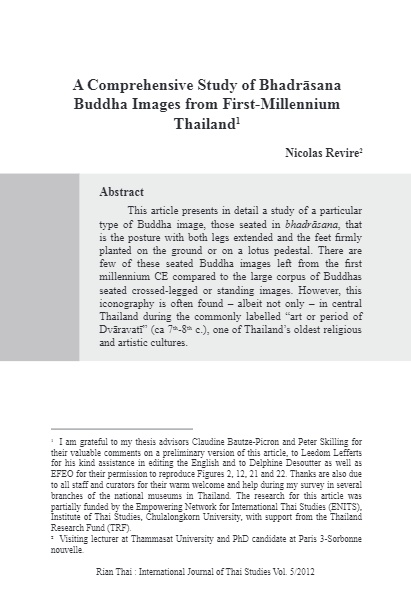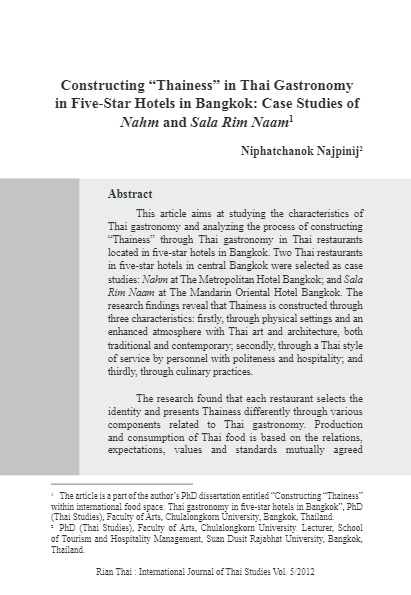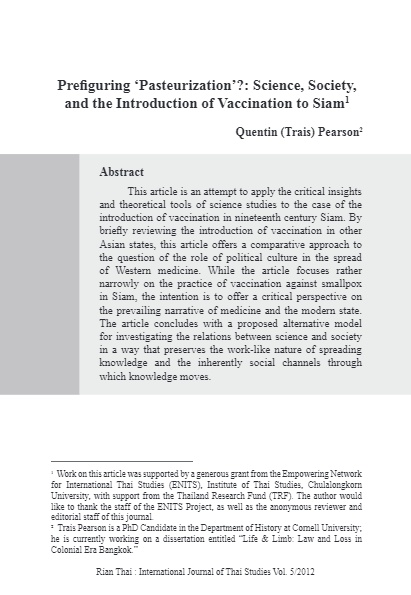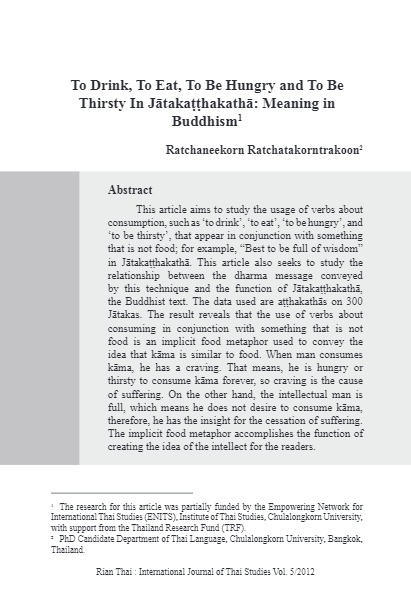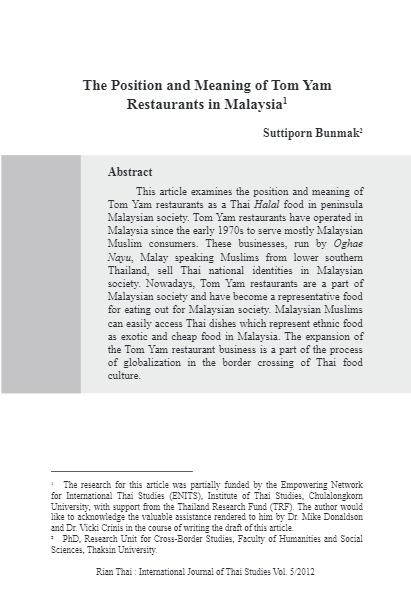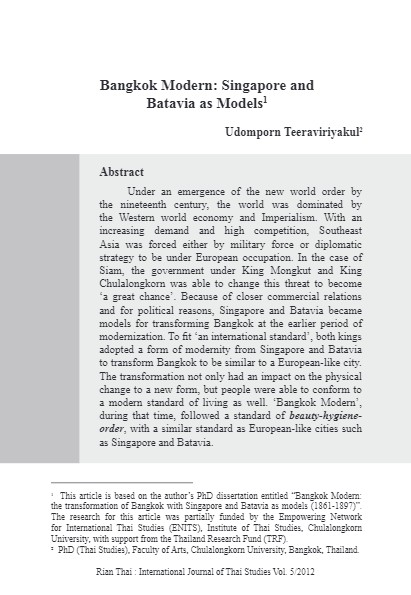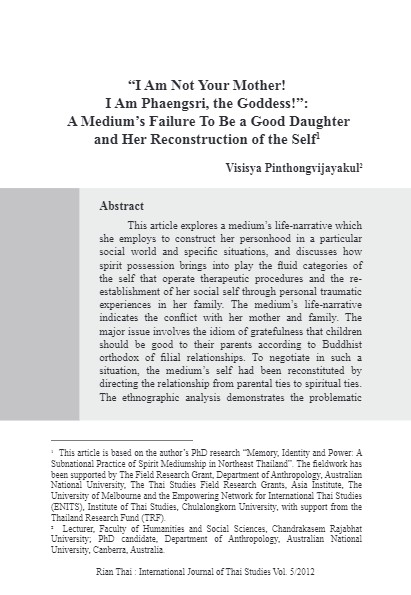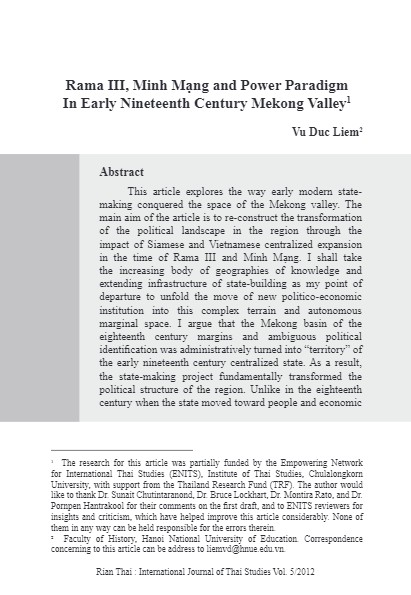Rian Thai - Volume 5/2012
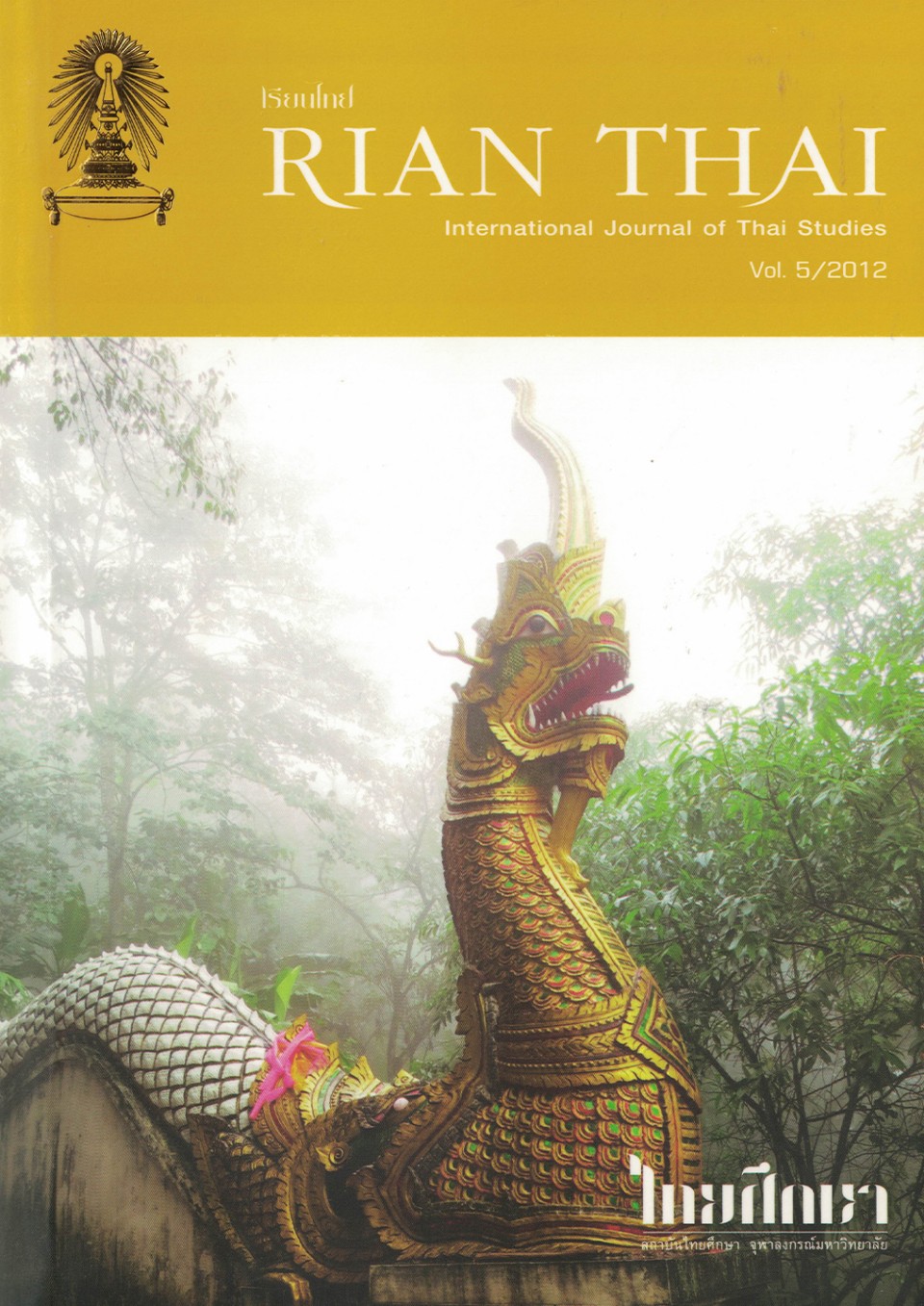
1) Persistence and Transmission of Monness in Funeral Rites : A Case Study of Mons at Ko Kret / Chayanut Intudom
2) Consumption of Globalized Food Among Isan Women in Bangkok : Globalization Vs Localization / Helle B. M. Aasheim
3) Framing Religious Injustice : Thai Sangha’s Discourse on Buddhism Protection in the 21st Century / Katewadee Kulabkaew
4) US Popular Representations of Thailand and the Construction of Uniqueness during the Cold War / Matthew Phillips
5) A Comprehensive Study of Bhadrasana Buddha Images from First-Millennium Thailand / Nicolas Revire
6) Constructing “Thainess” in Thai gastronomy in Five-Star Hotels in Bangkok : Case studies of “Nahm” and “Sala Rim Naam” / Niphatchanok Najpinij
7) Prefiguring ‘Pasteurization’? : Science, Society, and the Introduction of Vaccination to Siam / Quentin (Trais) Pearson
8) To Drink, To Eat, To be Hungry and To be Thirsty in Jatakatthakatha : Meaning in Buddhism / Ratchaneekorn Ratchatakorntrakoon
9) The Position and Meaning of Tom Yam Restaurants in Malaysia / Suttiporn Bunmak
10) Bangkok Modern : Singapore and Batavia as models / Udomporn Teeraviriyakul
11) “I Am Not Your Mother! I Am Phaengsri, the Goddess!” : A Medium’s Failure To Be A Good Daughter And Her Reconstruction of the Self / Visisya Pinthongvijayakul
12) Rama III, Minh Mang and Power Paradigm in Early Nineteenth Century Mekong Valley / Vu Duc Liem
Persistence and Transmission of Monness in Funeral Rites : A Case Study of Mons at Ko Kret
Chayanut Intudom
Abstract
Ko Kret, a Mon community in Pak Kret District, Nonthaburi Province, in the central part of Thailand, at present has been very much exposed to tourism. The community receives a great number of visitors both Thais and foreigners, particularly on the weekends. From this aspect, it might be assumed that the ethnic Mon people at Ko Kret would have been completely absorbed by their host society, and Monness may have long vanished.
As a result of my research, it is evident that Monness can still be identified through Mon beliefs and rituals, which can be seen by the Mon funeral rites described in this article. Much of these rites still followed the old traditions, and Monness can still be traced through the practices, beliefs and ritual objects. The analysis of Mon funeral rites reveals the persistence of Monness seen particularly, in the case of funerals for monks, in the making and the style of coffins, pyres and fireworks; and in the case of laymen, in beds, personal belongings of the dead, and the path and the
gate for the dead.
(Published in Rian Thai: International Journal of Thai Studies, Volume 5/2012, Page 1-24)
Full Text : Download
Consumption of Globalized Food Among Isan Women in Bangkok : Globalization Vs Localization
Helle B. M. Aasheim
Abstract
This article discusses a study of the consumption pattern of Western fast food among women from Isan who are working and living in Bangkok. The study investigated the extent to which Isan women incorporate the consumption of Western food into their own lives, and the extent to which this is done by the process of cultural heterogenization versus cultural homogenization. The case study informants came from various provinces in the northeastern region of Thailand. They were followed to their homes where their eating and consumption patterns were studied, and a general set of knowledge about their lives was acquired. Their consumption patterns in Bangkok were also studied and the data was connected to their consumption of fast food and was analyzed to draw some conclusions regarding their eating habits within a heterogenization-homogenization framework.
(Published in Rian Thai: International Journal of Thai Studies, Volume 5/2012, Page 25-42)
Full Text : Download
Framing Religious Injustice : Thai Sangha’s Discourse on Buddhism Protection in the 21st Century
Katewadee Kulabkaew
Abstract
As a response to the discourse that identifies monks as a root cause of the degeneration of Buddhism, the Thai Sangha has generated a counter-discourse of Buddhism Protection that tells the story of a weakened Buddhist society under threat from the subversive activities of foreign faiths. The discourse has been mainly publicized through the activism of the Sangha’s new movement – The Buddhism Protection Center of Thailand (BCT). An analysis of Buddhism protection discourse reveals an underlying cognitive frame that attempts to shape the mind of the Sangha and public audiences to spot injustice done to Buddhism by malevolent non-believers and an ignorant liberal state. The framing of religious injustice has ignited an ethno-nationalist sentiment, calling for collective action from Thai Buddhists in the re-nationalization of Buddhism.
(Published in Rian Thai: International Journal of Thai Studies, Volume 5/2012, Page 43-64)
Full Text : Download
US Popular Representations of Thailand and the Construction of Uniqueness during the Cold War
Matthew Phillips
Abstract
The Cold War in Southeast Asia is best understood as a battle for ideological hegemony in an era of decolonization. Successful projections of American power, therefore, could not only be opposed to communism, but also had to establish the idea of harmony between the interests of the United States and the developing world. It was for this reason that Thailand became a central location in the assertion of U.S. power in Southeast Asia. As the only country in the region to have remained free from imperial occupation, American popular culture repeatedly emphasised Thailand’s unique status, claiming that the country had survived the colonial period with much of its traditional identity intact. Yet, invariably, this image served to reproduce American ideology, familiarising the American public with a view of Thailand that made sense to their notion of the world in the context of the Cold War. This also presented Thailand as a safe and hospitable location, where Asia could be imagined as untroubled with American involvement, and where the Cold War could ultimately be won. Drawing from a range of American travel writing, articles and films from the 1950s, this article establishes how Thailand was successfully produced as an ideal location from which Americans might establish a ‘free world’ ideology.
(Published in Rian Thai: International Journal of Thai Studies, Volume 5/2012, Page 65-89)
Full Text : Download
A Comprehensive Study of Bhadrasana Buddha Images from First-Millennium Thailand
Nicolas Revire
Abstract
This article presents in detail a study of a particular type of Buddha image, those seated in bhadrāsana, that is the posture with both legs extended and the feet firmly planted on the ground or on a lotus pedestal. There are few of these seated Buddha images left from the first millennium CE compared to the large corpus of Buddhas seated crossed-legged or standing images. However, this iconography is often found – albeit not only – in central Thailand during the commonly labelled “art or period of Dvāravatī” (ca 7th-8th c.), one of Thailand’s oldest religious and artistic cultures.
(Published in Rian Thai: International Journal of Thai Studies, Volume 5/2012, Page 91-152)
Full Text : Download
Constructing “Thainess” in Thai gastronomy in Five-Star Hotels in Bangkok : Case studies of “Nahm” and “Sala Rim Naam”
Niphatchanok Najpinij
Abstract
This article aims at studying the characteristics of Thai gastronomy and analyzing the process of constructing “Thainess” through Thai gastronomy in Thai restaurants located in five-star hotels in Bangkok. Two Thai restaurants in five-star hotels in central Bangkok were selected as case studies: Nahm at The Metropolitan Hotel Bangkok; and Sala Rim Naam at The Mandarin Oriental Hotel Bangkok. The research findings reveal that Thainess is constructed through three characteristics: firstly, through physical settings and an enhanced atmosphere with Thai art and architecture, both traditional and contemporary; secondly, through a Thai style of service by personnel with politeness and hospitality; and thirdly, through culinary practices.
The research found that each restaurant selects the identity and presents Thainess differently through various components related to Thai gastronomy. Production and consumption of Thai food is based on the relations, expectations, values and standards mutually agreed between the “hosts” and “guests.” The production process also concerns Thai culinary regulations and, given the fact that these Thai restaurants are in an international food space, international standards must be implemented together with Thainess in the Thai food space. It was further found that the process of constructing meanings and Thainess is very dynamic since these Thai restaurants are situated in the context of globalization, thus, Thainess in Thai gastronomy is internationally negotiated.
(Published in Rian Thai: International Journal of Thai Studies, Volume 5/2012, Page 154-177)
Full Text : Download
Prefiguring ‘Pasteurization’? : Science, Society, and the Introduction of Vaccination to Siam
Quentin (Trais) Pearson
Abstract
This article is an attempt to apply the critical insights and theoretical tools of science studies to the case of the introduction of vaccination in nineteenth century Siam. By briefly reviewing the introduction of vaccination in other Asian states, this article offers a comparative approach to the question of the role of political culture in the spread of Western medicine. While the article focuses rather narrowly on the practice of vaccination against smallpox in Siam, the intention is to offer a critical perspective on the prevailing narrative of medicine and the modern state. The article concludes with a proposed alternative model for investigating the relations between science and society in a way that preserves the work-like nature of spreading knowledge and the inherently social channels through which knowledge moves.
(Published in Rian Thai: International Journal of Thai Studies, Volume 5/2012, Page 179-208)
Full Text : Download
To Drink, To Eat, To be Hungry and To be Thirsty in Jatakatthakatha : Meaning in Buddhism
Ratchaneekorn Ratchatakorntrakoon
Abstract
This article aims to study the usage of verbs about consumption, such as ‘to drink’, ‘to eat’, ‘to be hungry’, and ‘to be thirsty’, that appear in conjunction with something that is not food; for example, “Best to be full of wisdom” in Jātakaṭṭhakathā. This article also seeks to study the relationship between the dharma message conveyed by this technique and the function of Jātakaṭṭhakathā, the Buddhist text. The data used are aṭṭhakathās on 300 Jātakas. The result reveals that the use of verbs about consuming in conjunction with something that is not food is an implicit food metaphor used to convey the idea that kāma is similar to food. When man consumes kāma, he has a craving. That means, he is hungry or thirsty to consume kāma forever, so craving is the cause of suffering. On the other hand, the intellectual man is full, which means he does not desire to consume kāma, therefore, he has the insight for the cessation of suffering. The implicit food metaphor accomplishes the function of creating the idea of the intellect for the readers.
(Published in Rian Thai: International Journal of Thai Studies, Volume 5/2012, Page 209-225)
Full Text : Download
The Position and Meaning of Tom Yam Restaurants in Malaysia
Suttiporn Bunmak
Abstract
This article examines the position and meaning of Tom Yam restaurants as a Thai Halal food in peninsula Malaysian society. Tom Yam restaurants have operated in Malaysia since the early 1970s to serve mostly Malaysian Muslim consumers. These businesses, run by Oghae Nayu, Malay speaking Muslims from lower southern Thailand, sell Thai national identities in Malaysian society. Nowadays, Tom Yam restaurants are a part of Malaysian society and have become a representative food for eating out for Malaysian society. Malaysian Muslims can easily access Thai dishes which represent ethnic food as exotic and cheap food in Malaysia. The expansion of the Tom Yam restaurant business is a part of the process of globalization in the border crossing of Thai food culture.
(Published in Rian Thai: International Journal of Thai Studies, Volume 5/2012, Page 227-248)
Full Text : Download
Bangkok Modern : Singapore and Batavia as models
Udomporn Teeraviriyakul
Abstract
Under an emergence of the new world order by the nineteenth century, the world was dominated by the Western world economy and Imperialism. With an increasing demand and high competition, Southeast Asia was forced either by military force or diplomatic strategy to be under European occupation. In the case of Siam, the government under King Mongkut and King Chulalongkorn was able to change this threat to become ‘a great chance’. Because of closer commercial relations and for political reasons, Singapore and Batavia became models for transforming Bangkok at the earlier period of modernization. To fit ‘an international standard’, both kings adopted a form of modernity from Singapore and Batavia to transform Bangkok to be similar to a European-like city. The transformation not only had an impact on the physical change to a new form, but people were able to conform to a modern standard of living as well. ‘Bangkok Modern’, during that time, followed a standard of beauty-hygiene order, with a similar standard as European-like cities such as Singapore and Batavia.
This article examines how Bangkok was initially reconstructed with the concept of a modern city. In particular, after visiting Singapore and Java (Batavia and Semarang) in 1871, King Chulalongkorn adopted a form of ‘modernity’ from both colonial cities to transform Bangkok during the earlier years of his reign.
(Published in Rian Thai: International Journal of Thai Studies, Volume 5/2012, Page 249-273)
Full Text : Download
“I Am Not Your Mother! I Am Phaengsri, the Goddess!” : A Medium’s Failure To Be A Good Daughter And Her Reconstruction of the Self
Visisya Pinthongvijayakul
Abstract
This article explores a medium’s life-narrative which she employs to construct her personhood in a particular social world and specific situations, and discusses how spirit possession brings into play the fluid categories of the self that operate therapeutic procedures and the reestablishment of her social self through personal traumatic experiences in her family. The medium’s life-narrative indicates the conflict with her mother and family. The major issue involves the idiom of gratefulness that children should be good to their parents according to Buddhist orthodox of filial relationships. To negotiate in such a situation, the medium’s self had been reconstituted by directing the relationship from parental ties to spiritual ties. The ethnographic analysis demonstrates the problematic issues of kinship ties, local politics, and the meaning of health in a village in northeast Thailand in line with social change and capitalized forces in modern Thai society.
(Published in Rian Thai: International Journal of Thai Studies, Volume 5/2012, Page 275-292)
Full Text : Download
Rama III, Minh Mang and Power Paradigm in Early Nineteenth Century Mekong Valley
Vu Duc Liem
Abstract
This article explores the way early modern statemaking conquered the space of the Mekong valley. The main aim of the article is to re-construct the transformation of the political landscape in the region through the impact of Siamese and Vietnamese centralized expansion in the time of Rama III and Minh Mạng. I shall take the increasing body of geographies of knowledge and extending infrastructure of state-building as my point of departure to unfold the move of new politico-economic institution into this complex terrain and autonomous marginal space. I argue that the Mekong basin of the eighteenth century margins and ambiguous political identification was administratively turned into “territory” of the early nineteenth century centralized state. As a result, the state-making project fundamentally transformed the political structure of the region. Unlike in the eighteenth century when the state moved toward people and economic centers, early nineteenth century witnessed various forms by which people voluntarily, or were forced, to move along with state establishment. Centers had been mapped and the state administrative network paved the way for reorganizing the political structure of the region, paralleled by both Siamese and Vietnamese nation-building. By looking at the Siamese and Vietnamese expansion along the Mekong basin, not from the perspective of confrontation, but in the context of power transformation throughout the basin, a convergence between them can be drawn: that is, the extensive expansion of the state into mountains, hills, and swamps by creating canals, routes, military fortresses and by collecting immigrants at the frontier to set up settlements and administrative networks. The state conquest into the periphery and semi-periphery was in a larger scale than ever before and created a fundamental transformation from the “periphery” into the “geobody” of the central state.
(Published in Rian Thai: International Journal of Thai Studies, Volume 5/2012, Page 293-326)
Full Text : Download

